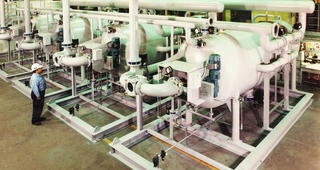Industrial ion exchange (IX) water softeners from Veolia Water Technologies are engineered and fabricated specifically for demanding high Total Dissolved Solids applications.
Overview
SAC SOFTENERS
Whittier® Strong Acid Cation (SAC) exchangers produce softened, zero hardness water with a Total Dissolved Solids (TDS) concentration up to 7,000 ppm. As the water passes through the bed of SAC exchange resin all bivalent ions associated with hardness are swapped for sodium ions. Upon regeneration, the saturated resin is brought into contact with sodium ions (in the form of brine) to force the reaction back into chemical equilibrium again.
SAC systems are usually operated in series with both a primary and a polishing vessel containing SAC resin. This configuration regenerates the polishing softener counter-currently by using a high concentration salt solution. Later, the brine is directed to the primary softener at a more efficient concentration in a co-current fashion to obtain the highest capacity. The brine, loaded with hardness, is discharged.
Proven methods and designs allow the lowest hardness leakage. Optional control valves are incorporated to air/gas scour or detergent/surfactant clean the ion exchange resins when they are fouled with oil. The materials of construction are compatible with produced water at temperatures up to 200ºF.
WAC SOFTENERS
Whittier® Weak Acid Cation (WAC) exchangers are the best in the industry as they are capable of producing softened water with low hardness levels of 0.2 PPM from water with a Total Dissolved Solids (TDS) concentration of up to 18,000 PPM. High TDS levels make more difficult the achievement of low leakage due to the chemical competition between sodium and hardness.
When using WAC resins, the resulting hardness in the treated water is determined by the sodium concentration because it competes with the ion exchange reaction. Due to its low affinity with sodium ions, the WAC resin is regenerated differently. In WAC resin in Na+ form, HCl is used to remove hardness from the resin as NaOH is applied later to replace H+ by Na+. Although WAC in H+ form is a proven method with good softening ability for brackish water, it is limited to the removal of hardness associated with alkalinity.
The use of the WAC-Na process is more robust than WAC-H against changes in alkalinity and also more efficient at swapping Na+ for any other cation upon exhaustion of the resin. This is the reason WAC resins are preferred in case background TDS is high or the outlet requires a very low hardness. Highly efficient regeneration is achieved utilizing a lower strainer plate design and a dedicated regeneration distributor. The materials of construction are suitable for high temperature, corrosive operation, and exposure to aggressive regeneration chemicals.
BRINE SOFTENERS
This special design uses select chelating Ion Exchange resin capable of removing hardness to 10 PPB on concentrated brine to produce high quality brine that can be used in a membrane cell electrolyzer for the production of chlorine and caustic. The design and materials of construction are critical, especially the choice of elastomers, which need to be resistant to any hardness leaching during operation.
Regeneration is performed using HCl and NaOH with a lower strainer plate and a dedicated regeneration distributor. This service is very demanding and requires the most efficient design to obtain this quality.
REGENERATION STATIONS
Veolia also provides regeneration stations including brine makers, Sulfuric Acid (H2SO4), Hydrochloric Acid (HCl) and Sodium Hydroxide (NaOH) storage tanks and dosing pumps, and neutralization systems for ion exchange regeneration waste.
We offer monitoring equipment to allow for recycling of waste water to reduce the volume of concentrated waste. These systems can also be automated using the PLC controls supplied with the ion exchange trains.
PRETREATMENT OF ION EXCHANGE FEED WATER
Pre-filtration with multi-media filters is a basic requirement for all Ion Exchange applications as any particulate matter will be detrimental to the operation and maintenance of the columns. Oil and Grease must also be kept out of the system because ion exchange resins are susceptible to fouling which would require a surfactant wash procedure that may accelerate the chemical aging of the resin.
SPECIALTY SYSTEMS
Specialty applications, such as metals recovery, arsenic removal and heavy metals removal are also possible with Whittier® columns by using specialized ion-exchange resins.






